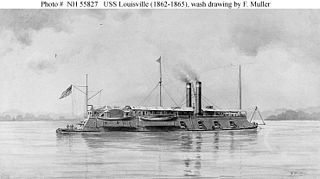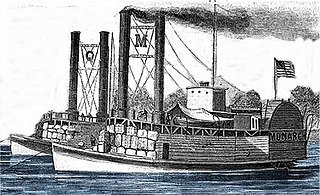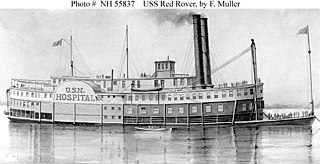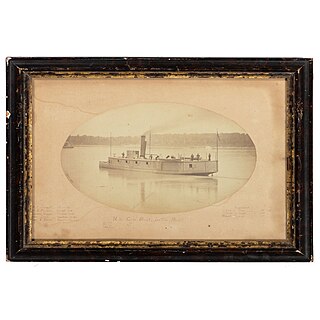
The third USS Lexington was a timberclad gunboat in the United States Navy during the American Civil War.

The first USS Lafayette was a side wheel steamer, converted to an ironclad ram, in the United States Navy during the American Civil War.

USS Louisville was a City-class ironclad gunboat constructed for the U.S. Army by James B. Eads during the American Civil War.
USS Glide was a sternwheel steamer that served as a tinclad warship during the American Civil War. Built in 1862, she was purchased for military service late that year by the Union Navy. After being converted to a tinclad and armed with six 24-pounder Dahlgren guns, she entered service with the Mississippi River Squadron in early January 1863. Later that month, she saw action in the Battle of Arkansas Post, firing on Confederate-held Fort Hindman. Sent the next month to Cairo, Illinois, for repairs, Glide was destroyed in a fire of uncertain origin on February 7.

USS Marmora was a sternwheel steamer that served in the Union Navy from 1862 to 1865, during the American Civil War. Marmora was built in 1862 at Monongahela, Pennsylvania, as a civilian vessel. She was purchased for military service on September 17 and converted into a tinclad warship. Commissioned on October 21, the vessel served on the Yazoo River beginning the next month. She encountered Confederate naval mines on the Yazoo on December 11, and was present the next day when the ironclad USS Cairo was sunk by two mines. After further service on the Yazoo during the Battle of Chickasaw Bayou in late December, Marmora was assigned in January 1863 to a fleet that was preparing to operate against Confederate Fort Hindman, but was not present when the fort surrendered on January 11.

USS Monarch was a United States Army sidewheel ram that saw service in the American Civil War as part of the United States Ram Fleet and the Mississippi Marine Brigade. She operated on the Mississippi River and Yazoo River during 1862 and 1863.

USS General Bragg was a heavy (1,043-ton) steamer captured by Union Navy forces during the American Civil War. She was outfitted as a U.S. Navy gunboat and was assigned to enforce the Union blockade of the waterways of the Confederate States of America.

USS Red Rover was a 650-ton Confederate States of America steamer that the United States Navy captured. After refitting the vessel, the Union used it as a hospital ship during the American Civil War.

Little Rebel was a cotton-clad ram that had been converted from a Mississippi River steamer to serve as the flagship of the Confederate River Defense Fleet in the American Civil War. Sent from New Orleans to defend against the Federal descent of the Mississippi, she was among the force that engaged vessels of the Union Army's Western Gunboat Flotilla at the Battle of Plum Point Bend on May 10, 1862. On June 6, she again was involved in an action with the Federal gunboats, this time at the Battle of Memphis. In the battle, a shot from a Federal gun pierced her boiler, disabling her, and she was then pushed aground by the Federal ram USS Monarch and captured.

USS Rattler was a steamer acquired by the Union Navy during the American Civil War.

USS St. Clair was a steamer purchased by the Union Navy during the American Civil War.

USS Eastport was a steamer captured by the Union Navy during the American Civil War. She was used by the Union Navy as a convoy and patrol vessel on Confederate waterways.
USS Judge Torrence was a steamer acquired by the Union Navy during the American Civil War. She was used by the Union Navy as an ammunition ship in support of the Union Navy.
USS Juliet was a steamer acquired by the Union Navy during the American Civil War. She was used by the Union Navy as a gunboat in support of the Union Navy blockade of Confederate waterways.
USS Alfred Robb was a stern wheel steamer captured by the Union Navy during the American Civil War.
USS Alonzo Child was a side-wheel steamer seized by the Union Navy during the American Civil War. She was used by the Union Navy as a barracks ship in support of the Union Navy blockade of Confederate waterways.
USS New National was a large side wheel steamer seized by the Union Navy during the American Civil War. She was used by the Union Navy as a troop ship and receiving ship in support of the Union Navy blockade of Confederate waterways.
USS Arletta was a schooner acquired by the Union Navy during the American Civil War. She was used by the Union Navy as a gunboat and, at times, an ammunition ship, in support of the Union Navy blockade of Confederate waterways.
The first USS Sovereign was a 336-ton steamer captured on the Mississippi River by the Union Navy during the beginning of the American Civil War.
USS Romeo was a sternwheel steamer that saw service as a tinclad warship during the American Civil War. Completed in August 1862 for civilian trade on the Wabash River, she was instead purchased by the Union Navy for military service in October. Commissioned in December, she cleared naval mines on the Yazoo River later that month before participating in the operations against Confederate-held Fort Hindman in January 1863. After the fall of Fort Hindman, Romeo was part of an expedition up the White River. In February and March 1863, she was part of the Yazoo Pass Expedition, and she fought with Confederates at river landings later in the year to help isolate Vicksburg, Mississippi, during the Vicksburg campaign.










